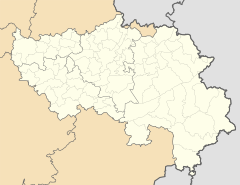Lontzen
| Lontzen | ||
|---|---|---|

|

|
|
|
|
||
| State : |
|
|
| Region : | Wallonia | |
| Province : | Liege | |
| District : | Verviers | |
| Coordinates : | 50 ° 41 ′ N , 6 ° 0 ′ E | |
| Area : | 28.82 km² | |
| Residents: | 5764 (Jan. 1, 2019) | |
| Population density: | 200 inhabitants per km² | |
| Height: | 250 m | |
| Post Code: | 4710, 4711 | |
| Prefix: | 087 | |
| Mayor: | Patrick Thevissen PFF | |
Local government address : |
Kirchstrasse 46 4710 Lontzen |
|
| Website: | www.lontzen.be | |
Lontzen is a municipality in the Belgian province of Liège and is located in the northwest of the German-speaking community in Belgium, which consists of nine municipalities , which directly borders the French-speaking part of Wallonia . It is located north of the High Fens and is connected to the E40 motorway (Aachen-Brussels). The municipality of Lontzen consists of the municipalities of Lontzen with Lontzen-Busch , Herbesthal and Walhorn with Astenet and Rabotrath, which were merged in 1977 .
history
Finds of ceramic shards indicate a settlement in the Celtic times. The first documentary mention dates back to April 21, 1076, when King Henry IV donated the bailiffs of Lontzen, Walhorn and Mesch (near Montzen ) to the Marienstift in Aachen . A first chapel was replaced by a parish church in 1328. Until the French Revolution, Lontzen was part of the Duchy of Limburg . From 1795 it belonged to the French Ourthe department . By the Paris Peace of May 30, 1814, Lontzen was again separated from France and assigned to Prussia in accordance with the decisions of the Congress of Vienna in 1815. Lontzen initially belonged to the Grand Duchy of Lower Rhine (1822 to the Rhine Province ) and the Eupen district . At that time, German was recognized as the official language. The Treaty of Versailles, concluded in 1919, stipulated that the region, including Lontzen, belonged to Belgium with effect from January 10, 1920. It was annexed by the German Reich between 1940 and 1944 . Since the end of the Second World War , Lontzen has been part of Belgium again.
Parish church
The parish church of St. Hubertus was built on the foundations of a previous building; it was planned by the architect Joseph Moretti and realized between 1768 and 1772. The octagonal tower with its distinctive tower dome from 1910 replaces the original, dilapidated classic tower from the 14th century. The elaborate vault frescos in Art Deco style with biblical scenes date from between 1906 and 1908 and were made by Carl Bränner. The organ from the Orgelbau Schumacher workshop in Eupen dates from 1989, the modified construction allows a view of the round window in the tower. In the first 15 years of the 21st century, the church was extensively restored in several steps.
landscape
The distinctive meadow landscape has its origin in the dairy cattle breeding of the local farmers, which is usually found. Several left tributaries of the Göhl have their source in the municipality. Lontzen lies on the upper reaches.
politics
The PFF (Energy List) provides Mayor Patrick Thevissen in coalition with ECOLO . The other parties represented in the municipal council are CSP (Union) and List Plus (Local Voting Association).
Attractions
- Village festival with vintage tractor exhibition with around 300 tractors on the third Sunday in August
- Village history collection (DGS) in the Lontzen village house
- In 2006 the “Village History Collection” moved to its new home “Das Dorfhaus”
- Sankt Hubertuskirche on a hill in the village center, built between 1768 and 1771
- Lontzen Castle (for many years the residence of the Eupen District Administrator Bernhard von Scheibler's family )
- St. Anne's Chapel in Lontzen-Busch
- Sankt Stephanuskirche zu Walhorn
- former Herbesthal train station
Economy and Transport
The municipality is from southwest to northeast by the here directly alongside each other roads of the railway speed leg HSL 3 and the motorway A 3 traversed.
In the southwest of the municipality, on the borders with Eupen and Welkenraedt , a new section of the intermunicipal industrial area East Belgian Park is being developed.
In Herbesthal there was a border station on the German-Belgian border for a long time .
Personalities
- Bernhard Paul Friedrich Hugo von Scheibler (1825–1888), justice of the peace and Prussian district administrator of the Monschau district .
- Joseph Cornelius Rossaint (1902–1991), resistance fighter and main defendant in the Berlin Catholic trial in 1937.
- Bernard Eicher (born December 6, 1933), politician of the Socialist Party , senator from 1981 to 1991.
- Hubert Chantraine (* 1945), Belgian doctor and politician, member of the Belgian Senate from 1995 to 1999.






